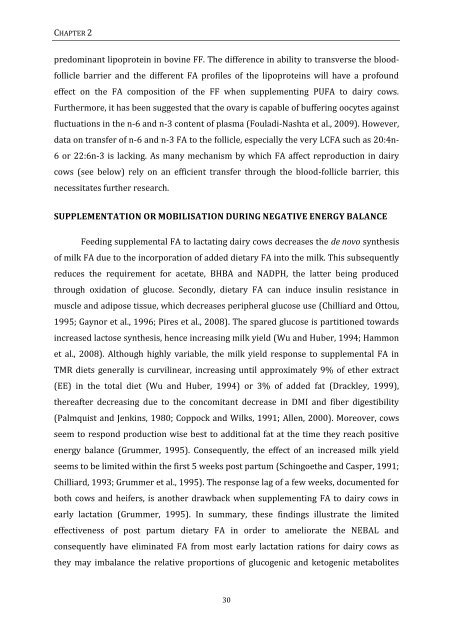view - Department of Reproduction, Obstetrics and Herd Health
view - Department of Reproduction, Obstetrics and Herd Health
view - Department of Reproduction, Obstetrics and Herd Health
You also want an ePaper? Increase the reach of your titles
YUMPU automatically turns print PDFs into web optimized ePapers that Google loves.
CHAPTER 2<br />
predominant lipoprotein in bovine FF. The difference in ability to transverse the bloodfollicle<br />
barrier <strong>and</strong> the different FA pr<strong>of</strong>iles <strong>of</strong> the lipoproteins will have a pr<strong>of</strong>ound<br />
effect on the FA composition <strong>of</strong> the FF when supplementing PUFA to dairy cows.<br />
Furthermore, it has been suggested that the ovary is capable <strong>of</strong> buffering oocytes against<br />
fluctuations in the n-6 <strong>and</strong> n-3 content <strong>of</strong> plasma (Fouladi-Nashta et al., 2009). However,<br />
data on transfer <strong>of</strong> n-6 <strong>and</strong> n-3 FA to the follicle, especially the very LCFA such as 20:4n-<br />
6 or 22:6n-3 is lacking. As many mechanism by which FA affect reproduction in dairy<br />
cows (see below) rely on an efficient transfer through the blood-follicle barrier, this<br />
necessitates further research.<br />
SUPPLEMENTATION OR MOBILISATION DURING NEGATIVE ENERGY BALANCE<br />
Feeding supplemental FA to lactating dairy cows decreases the de novo synthesis<br />
<strong>of</strong> milk FA due to the incorporation <strong>of</strong> added dietary FA into the milk. This subsequently<br />
reduces the requirement for acetate, BHBA <strong>and</strong> NADPH, the latter being produced<br />
through oxidation <strong>of</strong> glucose. Secondly, dietary FA can induce insulin resistance in<br />
muscle <strong>and</strong> adipose tissue, which decreases peripheral glucose use (Chilliard <strong>and</strong> Ottou,<br />
1995; Gaynor et al., 1996; Pires et al., 2008). The spared glucose is partitioned towards<br />
increased lactose synthesis, hence increasing milk yield (Wu <strong>and</strong> Huber, 1994; Hammon<br />
et al., 2008). Although highly variable, the milk yield response to supplemental FA in<br />
TMR diets generally is curvilinear, increasing until approximately 9% <strong>of</strong> ether extract<br />
(EE) in the total diet (Wu <strong>and</strong> Huber, 1994) or 3% <strong>of</strong> added fat (Drackley, 1999),<br />
thereafter decreasing due to the concomitant decrease in DMI <strong>and</strong> fiber digestibility<br />
(Palmquist <strong>and</strong> Jenkins, 1980; Coppock <strong>and</strong> Wilks, 1991; Allen, 2000). Moreover, cows<br />
seem to respond production wise best to additional fat at the time they reach positive<br />
energy balance (Grummer, 1995). Consequently, the effect <strong>of</strong> an increased milk yield<br />
seems to be limited within the first 5 weeks post partum (Schingoethe <strong>and</strong> Casper, 1991;<br />
Chilliard, 1993; Grummer et al., 1995). The response lag <strong>of</strong> a few weeks, documented for<br />
both cows <strong>and</strong> heifers, is another drawback when supplementing FA to dairy cows in<br />
early lactation (Grummer, 1995). In summary, these findings illustrate the limited<br />
effectiveness <strong>of</strong> post partum dietary FA in order to ameliorate the NEBAL <strong>and</strong><br />
consequently have eliminated FA from most early lactation rations for dairy cows as<br />
they may imbalance the relative proportions <strong>of</strong> glucogenic <strong>and</strong> ketogenic metabolites<br />
30









